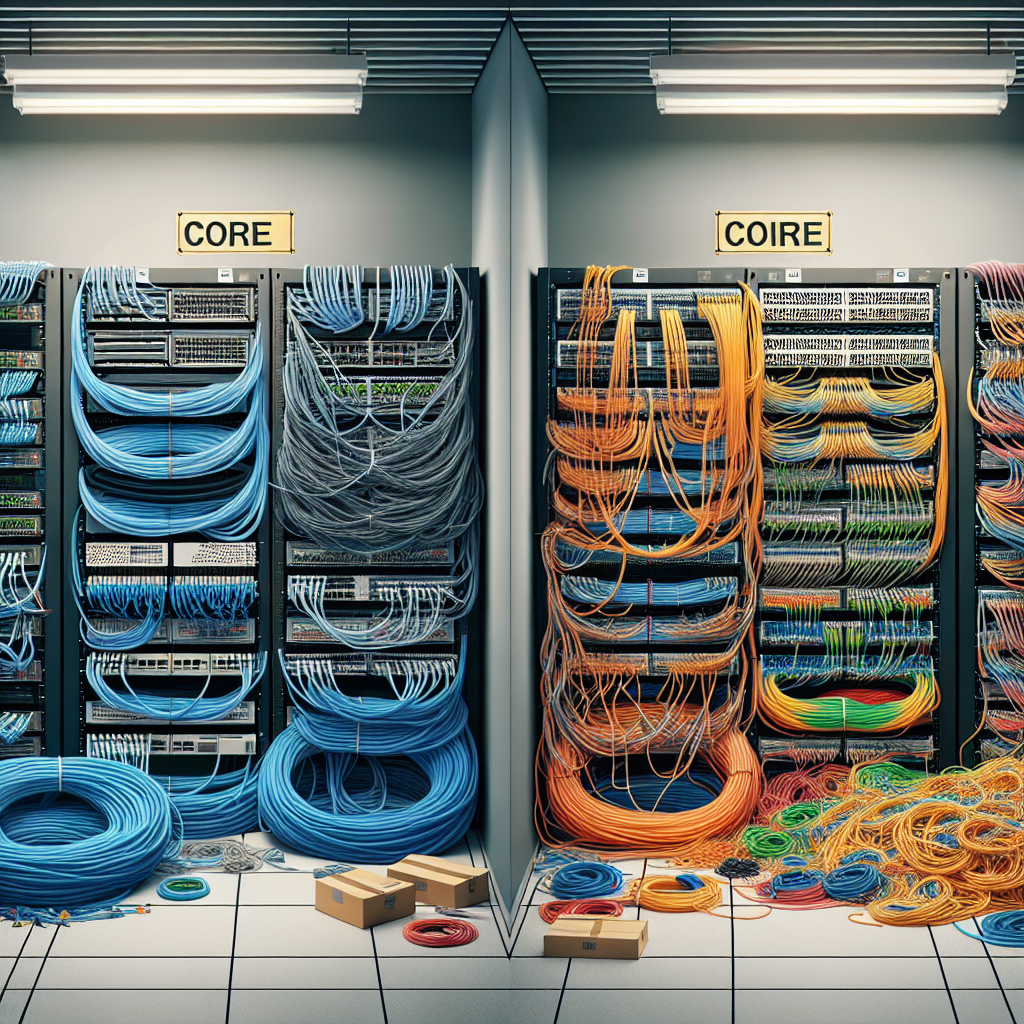Your cart is currently empty!
Tag: Smooth

Streamlining Data Center Audits: Tips for a Smooth and Efficient Process
Data center audits are crucial for ensuring that your organization’s IT infrastructure is secure, compliant, and running efficiently. However, these audits can be time-consuming and complex, often requiring a significant amount of resources to complete. In order to streamline the audit process and make it more efficient, there are a few key tips that organizations can follow.First and foremost, it is important to have a clear understanding of the scope and objectives of the audit. This includes identifying the specific areas of the data center that will be audited, as well as the goals that the audit aims to achieve. By clearly defining these parameters, organizations can ensure that the audit is focused and targeted, resulting in a more efficient process.
Another important tip for streamlining data center audits is to leverage automation and technology wherever possible. There are a variety of tools and software available that can help automate the audit process, from scanning and inventorying hardware and software assets to monitoring network traffic and security vulnerabilities. By using these tools, organizations can significantly reduce the amount of manual effort required for the audit, allowing for a more streamlined and efficient process.
Additionally, it is important to establish a standardized audit process and documentation framework. By creating a consistent methodology for conducting audits and documenting findings, organizations can ensure that the process is efficient and repeatable across different data center environments. This can also help to streamline communication and collaboration between audit teams, ensuring that all stakeholders are on the same page throughout the process.
In order to further streamline data center audits, organizations should also consider implementing regular monitoring and maintenance practices. By proactively monitoring the data center environment and addressing issues as they arise, organizations can prevent potential audit findings and ensure that the infrastructure remains secure and compliant. This can help to reduce the amount of remediation work required during the audit, making the process more efficient overall.
Finally, it is important to involve key stakeholders in the audit process from the beginning. By engaging with IT teams, security professionals, and other relevant departments early on, organizations can ensure that everyone is aligned on the objectives and goals of the audit. This can help to streamline communication and decision-making throughout the process, leading to a more efficient and effective audit overall.
In conclusion, streamlining data center audits is essential for ensuring that your organization’s IT infrastructure remains secure, compliant, and efficient. By following these tips and best practices, organizations can streamline the audit process, reduce manual effort, and improve overall efficiency. This can help to ensure that audits are completed in a timely manner and that any issues are addressed proactively, ultimately leading to a more secure and reliable data center environment.

The Importance of Data Center Capacity Planning: Ensuring Smooth Operations
In today’s digital age, data centers play a crucial role in the operations of businesses and organizations. They serve as the backbone of the IT infrastructure, housing and managing vast amounts of data that are essential for day-to-day operations. As such, it is important for data center capacity planning to be given due consideration to ensure smooth operations.Data center capacity planning is the process of determining the optimal amount of resources needed to support the current and future needs of an organization. This includes factors such as power, cooling, storage, and networking capacity. By properly planning for these resources, organizations can avoid issues such as downtime, performance bottlenecks, and costly upgrades.
One of the key reasons why data center capacity planning is important is to ensure that the data center can handle the increasing demands of the organization. With the exponential growth of data being generated and stored, organizations need to be proactive in planning for future capacity requirements. Failure to do so can result in performance issues, downtime, and potentially lost revenue.
Another important aspect of data center capacity planning is the efficient use of resources. By accurately forecasting the amount of resources needed, organizations can optimize their infrastructure and avoid overprovisioning, which can lead to wasted resources and increased costs. On the other hand, underprovisioning can result in performance issues and degraded user experience.
Furthermore, data center capacity planning is essential for ensuring business continuity and disaster recovery. By having the right amount of resources in place, organizations can better prepare for unforeseen events such as natural disasters or cyber-attacks. This allows for quicker recovery times and minimizes the impact on business operations.
In conclusion, data center capacity planning is a critical aspect of ensuring smooth operations for organizations. By accurately forecasting and planning for the resources needed, organizations can avoid performance issues, downtime, and costly upgrades. It is important for businesses to invest time and resources into capacity planning to support their current and future needs effectively.

Ensuring Smooth Operations: The Role of Data Center Servicing
In today’s digital age, data centers play a crucial role in ensuring the smooth operations of businesses and organizations. These facilities house and manage a vast amount of data, applications, and services that are essential for day-to-day operations. As such, it is imperative that data center servicing is carried out regularly to maintain optimal performance and reliability.Data center servicing involves a range of activities aimed at ensuring that the facility is running efficiently and effectively. This includes tasks such as equipment maintenance, software updates, security audits, and performance monitoring. By conducting regular servicing, data center operators can identify and address potential issues before they escalate into major problems that could disrupt operations.
One of the key roles of data center servicing is to prevent downtime. Downtime can be costly for businesses, leading to lost revenue, decreased productivity, and damage to the organization’s reputation. By proactively maintaining and servicing data center equipment, operators can minimize the risk of downtime and ensure that services remain available to users at all times.
Another important aspect of data center servicing is ensuring security. Data centers store sensitive and confidential information, making them a prime target for cyberattacks. Regular security audits and updates are essential to protect data from breaches and unauthorized access. By staying ahead of potential security threats, data center operators can safeguard their organization’s data and maintain the trust of their customers.
Performance monitoring is also a critical component of data center servicing. By tracking key performance metrics, operators can identify trends and patterns that may indicate potential issues with the facility’s infrastructure. This allows them to proactively address any issues before they impact performance and user experience.
In conclusion, data center servicing plays a vital role in ensuring the smooth operations of businesses and organizations. By conducting regular maintenance, security audits, and performance monitoring, data center operators can prevent downtime, enhance security, and optimize performance. Investing in proper data center servicing is essential for maintaining the reliability and efficiency of a data center, ultimately benefiting the organization as a whole.

Common Data Center Cabling Mistakes to Avoid: Tips for a Smooth Installation
Data centers are the backbone of modern businesses, housing crucial equipment and infrastructure that support the daily operations of organizations. However, the success of a data center installation heavily relies on the cabling infrastructure that connects various components and ensures seamless communication.Unfortunately, many data center installations are plagued by common cabling mistakes that can lead to downtime, inefficiency, and increased costs. To avoid these pitfalls and ensure a smooth installation, it’s important to be aware of these common data center cabling mistakes:
1. Lack of Proper Planning: One of the biggest mistakes in data center cabling is a lack of proper planning. It’s crucial to have a detailed cabling plan that considers the layout of the data center, the location of equipment, cable routing, and potential future expansion. Without a solid plan in place, cabling can become a tangled mess, making maintenance and troubleshooting a nightmare.
2. Overcrowded Cable Management: Another common mistake is overcrowding cable management systems. Too many cables in a small space can lead to cable tangling, signal interference, and difficulty accessing cables for maintenance. It’s important to leave enough space for cables to be neatly organized and easily accessible.
3. Improper Cable Lengths: Using cables that are too long or too short can cause connectivity issues and create a messy cabling environment. It’s important to measure and cut cables to the appropriate length to ensure a clean and efficient installation.
4. Ignoring Cable Labels: Proper labeling of cables is essential for easy identification and troubleshooting. Neglecting to label cables can lead to confusion, mistakes, and delays in resolving issues. Make sure to label each cable with its corresponding connection, location, and purpose.
5. Neglecting Cable Management Best Practices: Data center cabling should adhere to best practices for cable management, such as using cable trays, racks, and organizers to keep cables organized and secure. Neglecting these practices can result in cable damage, signal interference, and safety hazards.
6. Using Low-Quality Cables: Investing in high-quality cables is essential for a reliable and efficient data center installation. Using low-quality cables can lead to signal degradation, connectivity issues, and increased maintenance costs in the long run.
By avoiding these common cabling mistakes and following best practices for data center cabling, organizations can ensure a smooth installation that supports the reliability and performance of their data center infrastructure. Proper planning, organization, and attention to detail are key to a successful data center cabling installation.


